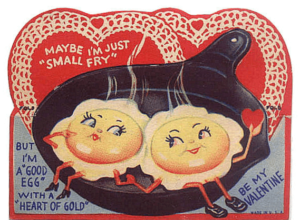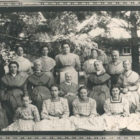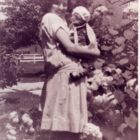One of the most well-known tenets of Shakerism is celibacy. Throughout their almost three centuries-long history, the Shakers have eschewed marriage and romantic relationships, organizing themselves into communal “families” of brethren and sisters and redefining what family means.
Love, however, was still a very important part of Shaker life, as it is for many Christian denominations and various other religions. In a letter to Isaac Newton Youngs, Elder Hervey Eads described the love the Shakers shared for one another as “love that surpasses all natural love.” This “gospel love,” as Shaker scholar Glendyne Wergland describes, is “a sentiment on a higher plane.”[1] Shaker spirituals are also filled with references to love, with titles like “Love is Little,” and “Love, More Love.”

It’s not surprising that Shakers who worked closely together for long periods of time developed close friendships that bordered on familial relationships. Wergland posits that “the nature of Shaker life promoted emotional attachments between men (and between women) . . .”[2] Oftentimes, young Shakers viewed mentors almost as parental figures, like Isaac N. Youngs and young Benjamin Gates, who referred to one another as “little Benny” and “daddy Isaac.” Women, too, created close personal friendships. A large photo of a group of twelve Shakers in our exhibit room has drawn much attention from visitors, as two of the sisters are holding hands. This was not an uncommon gesture between sisters. From an outside perspective, we – historians, educators, non-Shakers in a modern world – often learn or believe that all Shakers were to love one another equally; no one was better or worse than anyone else. In theory, that it is supposed to be true. But it’s impossible to spend almost every waking moment with someone and not bond with them in a strong way. It’s true that even those who left the Shakers (on good terms) returned sometimes to visit their old friends.
The photographic evidence, along with written records, demonstrates the love and affection Shakers felt for one another. Shaker letter writers often penned their desire for physical touch, which seems out of place. In an 1826 letter from a young Gates to his mentor Youngs, he writes: “Come home and see me so that I can stroke your head and kiss you once more as I used to.” Though this may seem strange to 21st century readers, Wergland asserts that “brethren were writing creatively to affirm gospel love rather than to express feelings motivated by lust” and that “their letters have been quoted out of context.”[3] She goes on to (correctly) state that we cannot apply modern interpretations to 19th century people. These letters, written from sister and sister and brother to brother, contain standard expressions of love of the time. Studies of correspondences between non-Shakers in the same period show similar exclamations of familial love between close friends.
The Shakers did not celebrate Valentine’s Day (though in the early 20th century, Shaker sisters sometimes threw Valentine’s parties for the children) but they expressed their love for one another each day. In today’s busy and hectic world, sometimes it’s hard to take the time to share a special moment or our feelings with those who are important to us. They know we love them, and we know they love us too. Yet we can all be inspired by the Shakers and strive to express how much our friends and family mean to us each and every day.

[1] Glendyne Wergland, One Shaker Life: Isaac Newton Youngs, 1793-1865 (Amherst: University of Massachusetts Press, 2006) 104
[2] Ibid. 95
[3] Ibid. 96









